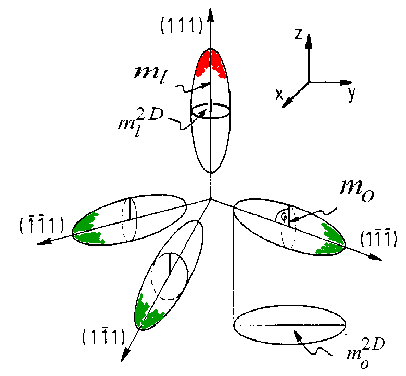Effective Masses
PbTe is a many valley semiconductor with 4 equivalent valleys in the band structure, which are oriented
parallel to the 4 < 111> directions located at the L-point. The growth direction is parallel to one < 111>
direction. With respect to the growth direction, which is also the direction of the potential modulation in a nipi-
structure, two sorts of carriers with different effective masses exist. The one ellipsoid which is parallel to the growth
direction (will be referenced as the longitudinal valley) leads to the longitudinal mass (ml = 0.25) for the
quantisation. The other 3 oblique valleys are equivalent and lead to an effective mass mo for quantisation, which is
nearly the transverse component of mt (mt = 0.025). The 2D - density of states of the subbands depends on the
components of the effective mass ellipsoid with respect to the in-plain (x-y-)directions. According to this the
subbands of the oblique valleys (small effective mass with respect to growth direction) has a higher density of states
mass as compared to the subbands of the longitudinal valley. If we also take into account that the oblique valleys
have a degeneracy of 3, it turns out that the total density of states of one subband from the oblique valleys is nearly
one order of magnitude higher than that of the longitudinal valley. Therefore one can expect that effects resulting
from the subband structure will clearly be dominated by the oblique valleys.

Fig.1: Schematic representation of the 4 equivalent effective mass ellipsoids. Essential are the components ml
and mo with respect to the growth direction for quantisation and the components ml2D and mo2D for the density of
states of the subbands.
The colors will be used as a reference to the contributions of the oblique valleys (green) and the longitudinal
valley (red) in serveral model calculations.

